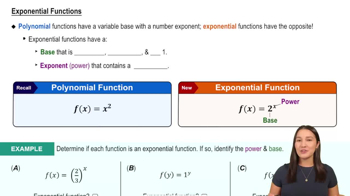Table of contents
- 0. Fundamental Concepts of Algebra3h 29m
- 1. Equations and Inequalities3h 27m
- 2. Graphs1h 43m
- 3. Functions & Graphs2h 17m
- 4. Polynomial Functions1h 54m
- 5. Rational Functions1h 23m
- 6. Exponential and Logarithmic Functions2h 28m
- 7. Measuring Angles40m
- 8. Trigonometric Functions on Right Triangles2h 5m
- 9. Unit Circle1h 19m
- 10. Graphing Trigonometric Functions1h 19m
- 11. Inverse Trigonometric Functions and Basic Trig Equations1h 41m
- 12. Trigonometric Identities 2h 34m
- 13. Non-Right Triangles1h 38m
- 14. Vectors2h 25m
- 15. Polar Equations2h 5m
- 16. Parametric Equations1h 6m
- 17. Graphing Complex Numbers1h 7m
- 18. Systems of Equations and Matrices3h 6m
- 19. Conic Sections2h 36m
- 20. Sequences, Series & Induction1h 15m
- 21. Combinatorics and Probability1h 45m
- 22. Limits & Continuity1h 49m
- 23. Intro to Derivatives & Area Under the Curve2h 9m
6. Exponential and Logarithmic Functions
Introduction to Exponential Functions
Struggling with Precalculus?
Join thousands of students who trust us to help them ace their exams!Watch the first videoMultiple Choice
Determine if the function is an exponential function.
If so, identify the power & base, then evaluate for x=4.
f(x)=(−2)x
A
Exponential function, f(4)=16
B
Exponential function, f(4)=−16
C
Not an exponential function
 Verified step by step guidance
Verified step by step guidance1
Step 1: Understand the definition of an exponential function. An exponential function is of the form f(x) = a^x, where 'a' is a positive constant and 'x' is the variable exponent.
Step 2: Examine the given function f(x) = (-2)^x. Here, the base is -2, which is not a positive constant. This violates the condition for a function to be exponential.
Step 3: Consider the implications of having a negative base. When the base is negative, the function does not exhibit the typical properties of exponential growth or decay, especially for non-integer values of x.
Step 4: Evaluate the function for x = 4. Substitute x = 4 into f(x) = (-2)^x to get f(4) = (-2)^4. Calculate the result to understand the behavior of the function.
Step 5: Conclude that since the base is negative, the function f(x) = (-2)^x is not an exponential function according to the standard definition.

 6:13m
6:13mWatch next
Master Exponential Functions with a bite sized video explanation from Patrick
Start learningRelated Videos
Related Practice


